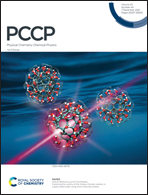Phase stability determination of negative thermal expansion silicates by theory and experiment†
Abstract
Materials that exhibit zero thermal expansion have numerous applications, ranging from everyday ceramic hobs to telescope mirrors to devices in optics and micromechanics. These materials include glass ceramics containing crystal phases with negative thermal expansion in at least one crystallographic direction, such as Ba1−xSrxZn2−2yMg2ySi2O7 solid solutions. However, the volume increase associated with the martensitic phase transformation in these crystals often hinders their use as zero thermal expansion materials at operating temperatures near the transition temperature Tt. Here, an approach to rapidly predict Tt of such materials as a function of chemical composition based on a combination of density functional theory simulations and experiments has been developed and applied to Ba1−xSrxZn2−2yMg2ySi2O7. Its central element is the modeling of free energy as a function of temperature and chemical composition using a composition-dependent Debye model augmented by an empirical correction, which incorporates the effects of anharmonic lattice vibrations. This approach provides Tt predictions with an estimated uncertainty of about ±100 K, which is similar to the accuracy of computationally much more demanding simulations of polymorphous phase transitions. In addition, this approach allows computationally efficient determination of the chemical compositions at which the Ba1−xSrxZn2−2yMg2ySi2O7 phase with the desired thermal properties will be formed during synthesis, facilitating the targeted design of zero thermal expansion materials.

- This article is part of the themed collection: 2021 PCCP HOT Articles


 Please wait while we load your content...
Please wait while we load your content...